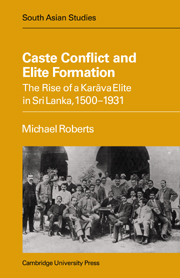Book contents
- Frontmatter
- Contents
- List of figures, chart and maps
- List of tables
- Preface
- Glossary
- List of abbreviations
- Map 1 The Kingdoms of Kotte and Kandy
- Map 2 Some physical features and place names
- Map 3 Present administrative divisions and the contemporary migration patterns of fishermen
- Map 4 The coastal waters of Sri Lanka and southeastern India
- 1 Introduction
- 2 The Karāva in the past
- 3 Caste among the Sinhalese
- 4 Economic opportunities and social relations, 1500s–1790s
- 5 The British period: the economic advances of a Karāva elite
- 6 Social competition, caste conflict and manifestations of Karāva power
- 7 Casteism in South Asian politics during British times: emergent cultural typifications or elite fictions?
- 8 Causal factors in the moulding of Karāva entrepreneurship and the emergence of a Karāva elite
- 9 Concluding remarks
- Tables
- Appendix 1 Problems and cautionary notes concerning the information derived from the plantation directories in the sequential series known as Ferguson's Ceylon Directory
- Appendix 2 A contemporary newspaper account of the reception provided for a Karāva notable on his receiving the title of ‘Mudaliyar of the Governor's Gate’ in 1853
- Appendix 3 A list of caste pamphlets and caste literature in chronological order, 1864–1930
- Select bibliography
- Index
8 - Causal factors in the moulding of Karāva entrepreneurship and the emergence of a Karāva elite
Published online by Cambridge University Press: 30 October 2009
- Frontmatter
- Contents
- List of figures, chart and maps
- List of tables
- Preface
- Glossary
- List of abbreviations
- Map 1 The Kingdoms of Kotte and Kandy
- Map 2 Some physical features and place names
- Map 3 Present administrative divisions and the contemporary migration patterns of fishermen
- Map 4 The coastal waters of Sri Lanka and southeastern India
- 1 Introduction
- 2 The Karāva in the past
- 3 Caste among the Sinhalese
- 4 Economic opportunities and social relations, 1500s–1790s
- 5 The British period: the economic advances of a Karāva elite
- 6 Social competition, caste conflict and manifestations of Karāva power
- 7 Casteism in South Asian politics during British times: emergent cultural typifications or elite fictions?
- 8 Causal factors in the moulding of Karāva entrepreneurship and the emergence of a Karāva elite
- 9 Concluding remarks
- Tables
- Appendix 1 Problems and cautionary notes concerning the information derived from the plantation directories in the sequential series known as Ferguson's Ceylon Directory
- Appendix 2 A contemporary newspaper account of the reception provided for a Karāva notable on his receiving the title of ‘Mudaliyar of the Governor's Gate’ in 1853
- Appendix 3 A list of caste pamphlets and caste literature in chronological order, 1864–1930
- Select bibliography
- Index
Summary
In seeking the factors that contributed towards the economic advances and the socio-political thrusts of the Karāva elite, any analysis must traverse three or four centuries. This demands attention to diachronic variations. Sequential developments might be perceived, turning-points located. The time-scale complicates the evaluation of causal factors. The isolation of a specific factor may raise questions about the conditions which spawned the factor. One gets pushed back in time till the historical records peter out. It is only with a limited regard for these time variations that this chapter proceeds. For the most part, the analysis will rely on controlled comparisons: that is, a method which compares the attributes, the relational features and the performance of two or more entities in order to isolate causal influences. The better-known examples of this strategy involve comparisons across pairs or multiples of contrasting polities so as to illuminate the varying processes of state formation or political modernisation or economic development. In contrast with these global-scale comparisons, in this study the strategy is applied within a single geographical unit and focuses on social groups as well as regional differences. The Karāva will not be viewed in isolation. The comparative performance of other segments of the Sinhalese community will be pinpointed in order to isolate differentiating factors. The categorisation of segments will be on a regional and socio-structural basis: the Sinhalese, the Low-Country Sinhalese, the Karāva– Salāgama–Durāva taken together, the Karāva and the Moratuwa Karāva. In sequence, each of these categories will be compared with the category that follows.
- Type
- Chapter
- Information
- Caste Conflict Elite Formation , pp. 225 - 282Publisher: Cambridge University PressPrint publication year: 1982



